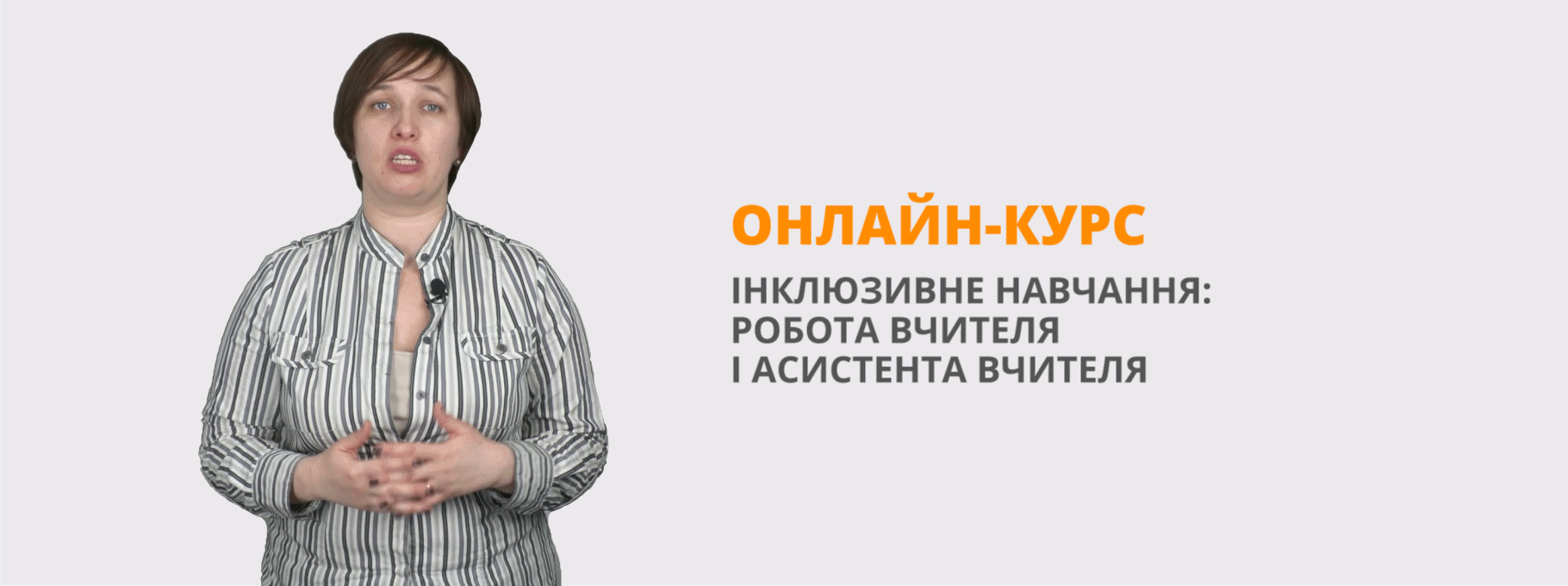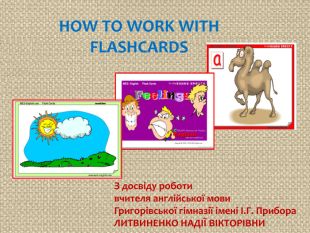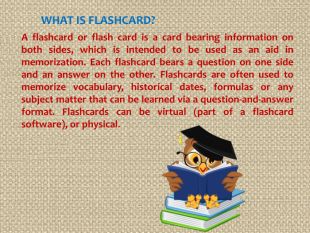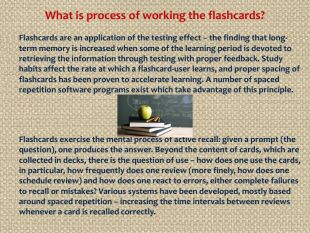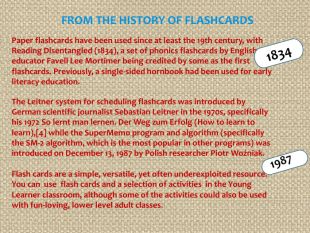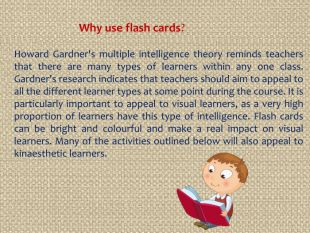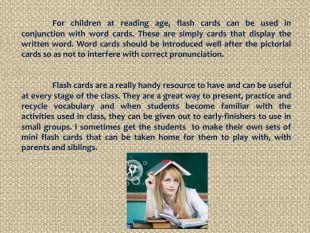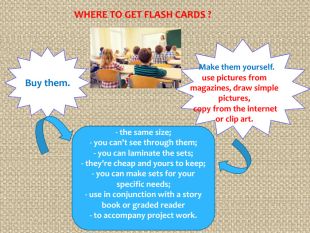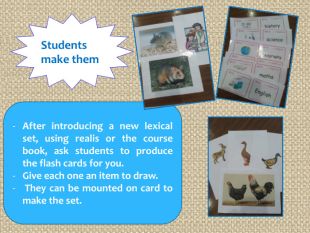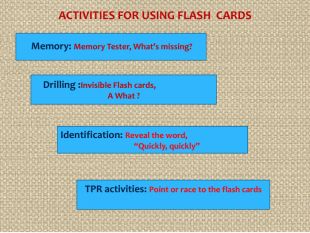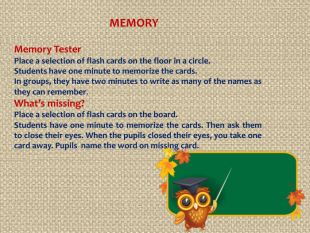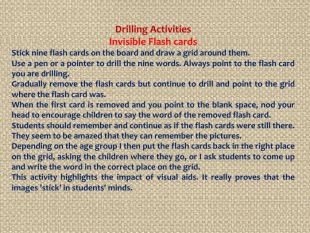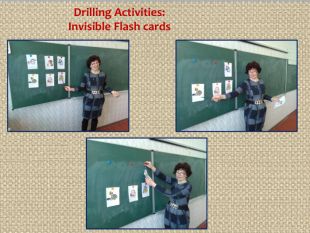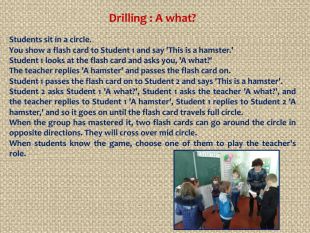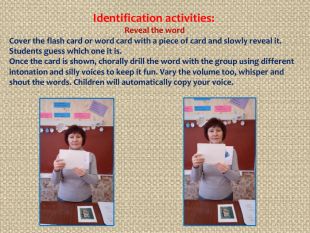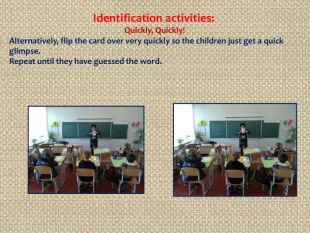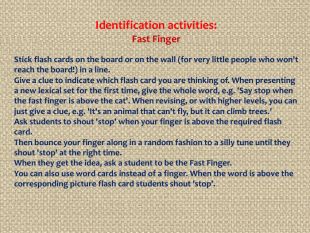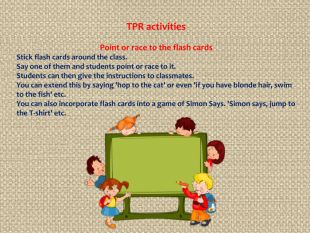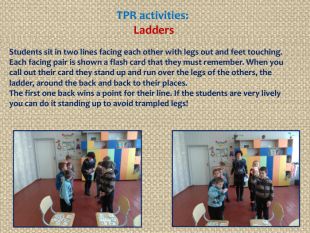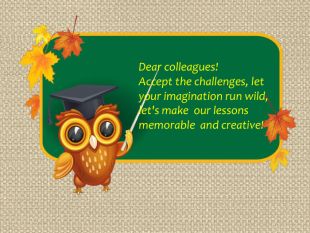Презентація "How To Use Flashcards"



![FROM THE HISTORY OF FLASHCARDSPaper flashcards have been used since at least the 19th century, with Reading Disentangled (1834), a set of phonics flashcards by English educator Favell Lee Mortimer being credited by some as the first flashcards. Previously, a single-sided hornbook had been used for early literacy education. The Leitner system for scheduling flashcards was introduced by German scientific journalist Sebastian Leitner in the 1970s, specifically his 1972 So lernt man lernen. Der Weg zum Erfolg (How to learn to learn),[4] while the Super. Memo program and algorithm (specifically the SM-2 algorithm, which is the most popular in other programs) was introduced on December 13, 1987 by Polish researcher Piotr Woźniak. Flash cards are a simple, versatile, yet often underexploited resource. You can use flash cards and a selection of activities in the Young Learner classroom, although some of the activities could also be used with fun-loving, lower level adult classes.1834183418341987 FROM THE HISTORY OF FLASHCARDSPaper flashcards have been used since at least the 19th century, with Reading Disentangled (1834), a set of phonics flashcards by English educator Favell Lee Mortimer being credited by some as the first flashcards. Previously, a single-sided hornbook had been used for early literacy education. The Leitner system for scheduling flashcards was introduced by German scientific journalist Sebastian Leitner in the 1970s, specifically his 1972 So lernt man lernen. Der Weg zum Erfolg (How to learn to learn),[4] while the Super. Memo program and algorithm (specifically the SM-2 algorithm, which is the most popular in other programs) was introduced on December 13, 1987 by Polish researcher Piotr Woźniak. Flash cards are a simple, versatile, yet often underexploited resource. You can use flash cards and a selection of activities in the Young Learner classroom, although some of the activities could also be used with fun-loving, lower level adult classes.1834183418341987](/uploads/files/17472/442460/503515_images/4.jpg)















WHAT IS FLASHCARD?A flashcard or flash card is a card bearing information on both sides, which is intended to be used as an aid in memorization. Each flashcard bears a question on one side and an answer on the other. Flashcards are often used to memorize vocabulary, historical dates, formulas or any subject matter that can be learned via a question-and-answer format. Flashcards can be virtual (part of a flashcard software), or physical.
What is process of working the flashcards?Flashcards are an application of the testing effect − the finding that long-term memory is increased when some of the learning period is devoted to retrieving the information through testing with proper feedback. Study habits affect the rate at which a flashcard-user learns, and proper spacing of flashcards has been proven to accelerate learning. A number of spaced repetition software programs exist which take advantage of this principle. Flashcards exercise the mental process of active recall: given a prompt (the question), one produces the answer. Beyond the content of cards, which are collected in decks, there is the question of use – how does one use the cards, in particular, how frequently does one review (more finely, how does one schedule review) and how does one react to errors, either complete failures to recall or mistakes? Various systems have been developed, mostly based around spaced repetition – increasing the time intervals between reviews whenever a card is recalled correctly.
FROM THE HISTORY OF FLASHCARDSPaper flashcards have been used since at least the 19th century, with Reading Disentangled (1834), a set of phonics flashcards by English educator Favell Lee Mortimer being credited by some as the first flashcards. Previously, a single-sided hornbook had been used for early literacy education. The Leitner system for scheduling flashcards was introduced by German scientific journalist Sebastian Leitner in the 1970s, specifically his 1972 So lernt man lernen. Der Weg zum Erfolg (How to learn to learn),[4] while the Super. Memo program and algorithm (specifically the SM-2 algorithm, which is the most popular in other programs) was introduced on December 13, 1987 by Polish researcher Piotr Woźniak. Flash cards are a simple, versatile, yet often underexploited resource. You can use flash cards and a selection of activities in the Young Learner classroom, although some of the activities could also be used with fun-loving, lower level adult classes.1834183418341987
Why use flash cards?Howard Gardner's multiple intelligence theory reminds teachers that there are many types of learners within any one class. Gardner's research indicates that teachers should aim to appeal to all the different learner types at some point during the course. It is particularly important to appeal to visual learners, as a very high proportion of learners have this type of intelligence. Flash cards can be bright and colourful and make a real impact on visual learners. Many of the activities outlined below will also appeal to kinaesthetic learners.
For children at reading age, flash cards can be used in conjunction with word cards. These are simply cards that display the written word. Word cards should be introduced well after the pictorial cards so as not to interfere with correct pronunciation. Flash cards are a really handy resource to have and can be useful at every stage of the class. They are a great way to present, practice and recycle vocabulary and when students become familiar with the activities used in class, they can be given out to early-finishers to use in small groups. I sometimes get the students to make their own sets of mini flash cards that can be taken home for them to play with, with parents and siblings.
WHERE TO GET FLASH CARDS ?Buy them. Make them yourself.use pictures from magazines, draw simple pictures, copy from the internet or clip art.- the same size;- you can't see through them;- you can laminate the sets; - they're cheap and yours to keep;- you can make sets for your specific needs; - use in conjunction with a story book or graded reader- to accompany project work.
MEMORYMemory Tester. Place a selection of flash cards on the floor in a circle. Students have one minute to memorize the cards. In groups, they have two minutes to write as many of the names as they can remember. What’s missing?Place a selection of flash cards on the board. Students have one minute to memorize the cards. Then ask them to close their eyes. When the pupils closed their eyes, you take one card away. Pupils name the word on missing card.
Drilling Activities. Invisible Flash cards. Stick nine flash cards on the board and draw a grid around them. Use a pen or a pointer to drill the nine words. Always point to the flash card you are drilling. Gradually remove the flash cards but continue to drill and point to the grid where the flash card was. When the first card is removed and you point to the blank space, nod your head to encourage children to say the word of the removed flash card. Students should remember and continue as if the flash cards were still there. They seem to be amazed that they can remember the pictures. Depending on the age group I then put the flash cards back in the right place on the grid, asking the children where they go, or I ask students to come up and write the word in the correct place on the grid. This activity highlights the impact of visual aids. It really proves that the images 'stick' in students' minds.
Drilling : A what? Students sit in a circle. You show a flash card to Student 1 and say 'This is a hamster.'Student 1 looks at the flash card and asks you, 'A what?'The teacher replies 'A hamster' and passes the flash card on. Student 1 passes the flash card on to Student 2 and says 'This is a hamster'. Student 2 asks Student 1 'A what?', Student 1 asks the teacher 'A what?', and the teacher replies to Student 1 'A hamster', Student 1 replies to Student 2 'A hamster,' and so it goes on until the flash card travels full circle. When the group has mastered it, two flash cards can go around the circle in opposite directions. They will cross over mid circle. When students know the game, choose one of them to play the teacher's role.
Identification activities: Reveal the word. Cover the flash card or word card with a piece of card and slowly reveal it. Students guess which one it is. Once the card is shown, chorally drill the word with the group using different intonation and silly voices to keep it fun. Vary the volume too, whisper and shout the words. Children will automatically copy your voice.
Identification activities: Fast Finger Stick flash cards on the board or on the wall (for very little people who won't reach the board!) in a line. Give a clue to indicate which flash card you are thinking of. When presenting a new lexical set for the first time, give the whole word, e.g. 'Say stop when the fast finger is above the cat'. When revising, or with higher levels, you can just give a clue, e.g. 'It's an animal that can't fly, but it can climb trees.'Ask students to shout 'stop' when your finger is above the required flash card. Then bounce your finger along in a random fashion to a silly tune until they shout 'stop' at the right time. When they get the idea, ask a student to be the Fast Finger. You can also use word cards instead of a finger. When the word is above the corresponding picture flash card students shout 'stop'.
TPR activities Point or race to the flash cards. Stick flash cards around the class. Say one of them and students point or race to it. Students can then give the instructions to classmates. You can extend this by saying 'hop to the cat' or even 'if you have blonde hair, swim to the fish' etc. You can also incorporate flash cards into a game of Simon Says. 'Simon says, jump to the T-shirt' etc.
TPR activities: Ladders Students sit in two lines facing each other with legs out and feet touching. Each facing pair is shown a flash card that they must remember. When you call out their card they stand up and run over the legs of the others, the ladder, around the back and back to their places. The first one back wins a point for their line. If the students are very lively you can do it standing up to avoid trampled legs!


про публікацію авторської розробки
Додати розробку
